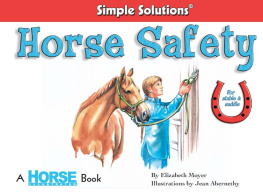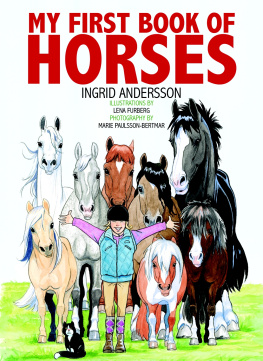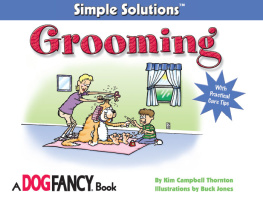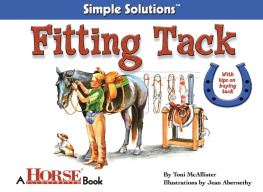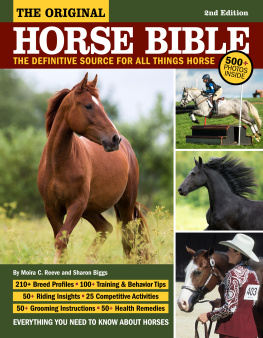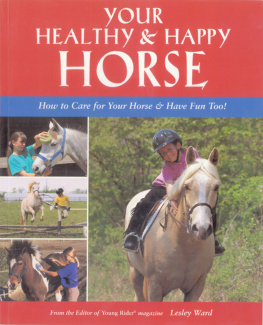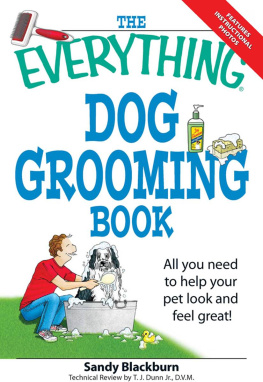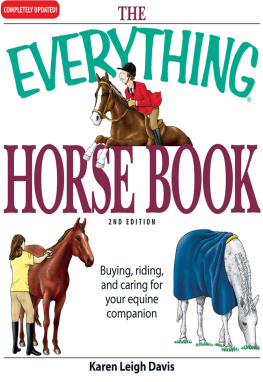Karla Austin, Business Operations Manager
Nick Clemente, Special Consultant
Barbara Kimmel, Managing Editor
Jessica Knott, Production Supervisor
Amy Stirnkorb, Designer
The horses in this book are referred to as she and he in alternating chapters unless their sexes are apparent from the activities discussed.
Copyright 2007 by I-5 Press
Illustrations copyright 2007 by Jean Abernethy
All rights reserved. No part of this book may be reproduced, stored in a retrieval system, or transmitted in any form or by any means, electronic, mechanical, photocopying, recording, or otherwise, without the prior written permission of I-5 Press, except for the inclusion of brief quotations in an acknowledged review.
Library of Congress Cataloging-in-Publication Data
Moyer, Elizabeth.
Grooming / by Elizabeth Moyer ; illustrations by Jean Abernethy.
p. cm. (Horse illustrated simple solutions)
ISBN-13: 978-1-931993-97-5
ISBN-10: 1-931993-97-1
eISBN-13: 978-1-620080-83-2
1. HorsesGrooming. I. Title.
SF285.7.M69 2007
636.10833dc22
2006038890
I-5 Press
A Division of I-5 Publishing, LLC
3 Burroughs
Irvine, California 92618
Printed and bound in Singapore
16 15 14 13 12 11 10 09 08 07 1 2 3 4 5 6 7 8 9 10
CONTENTS
The Benefits of Grooming
D aily grooming is an essential part of horse care. Its a simple process with many benefits and one of the first basic horsemanship skills to master. Most horses find grooming relaxing and enjoyable; in fact, many horse owners do, too! In addition to making your horse look nice, regular grooming benefits your horses health and well-being. This beauty treatment is more than skin deep!
Grooming for Health
Grooming promotes circulation, stimulates the skin, and massages the muscles. It brings out the shine in your horses coat by loosening dead hair, bringing up dirt and dandruff (scurf), and distributing the natural oils.

By grooming regularly, you can keep tabs on your horses weight and health. Youll become familiar with the landscape of her body and know what is normal for herand notice when something is amiss. As you groom, inspect your horse for cuts, skin irritations, unusual swellings, areas of pain or sensitivity, and anything else out of the ordinary. Horses groomed regularly stay healthier because someone is keeping a close eye on them to detect problems sooner rather than later. Although grooming adds polish, your horses shiny coat truly begins within. Good nutrition and regular health care are essential to keeping your horse looking and feeling her best.
Grooming for a Good Relationship
By providing hands-on time, grooming builds a relationship between you and your horse and helps strengthen your bond. Among horses, mutual groomingscratching with the teeth, nibbling, and so onis a friendly way they relate and show affection. Your grooming activities often mean the same thing to horses. Through this routine interaction, you will develop a feel for your horses general temperament, come to understand her quirks, and learn how to handle her effectively. In turn, she will learn where you stand in the hierarchy: grooming offers an opportunity to reinforce your leadership role and your horses respect for you.
The grooming process is a good way to get acquainted with a new horse. Even with a familiar horse, a preride grooming session lets you assess how your mount is feeling that day, giving you clues as to what may be in store once you get in the saddle. Is she relaxed? Grumpy? Nervous?

Grooming is a great get-to-know-you and get-to-know-you-better activity for both horse and human. By investing some time and using some elbow grease, youll be well acquainted with your horse on all levels and be able to take pride in her well-kept appearance.
Brushes and Tools
Y our grooming kit can be strictly functional or, if you really enjoy pampering your horse, filled with the newest types of colorful, specialized, ergonomically designed brushes and tools. For hygienic reasons, its best if each horse has an exclusive set of brushes and grooming tools because fungus can spread through shared grooming equipment. Brushes and grooming tools should be cleaned periodically. When necessary, soak them in diluted bleach, mild detergent or shampoo, and lay them out to dry.
Brushes come in a variety of textures and with either natural or synthetic bristles. Soft brushes and gentler tools can be used on the bony, sensitive areas of horses bodies; stiff brushes can tackle brawny regions and tough hides. Be attentive to your horses reactions, and pick the type of brush that seems most comfortable to him. If hes thin-skinned and sensitive, stiff, sharp bristles are tortuous and soft bristles more tolerable. If hes a tough, itchy guy with a yaklike coat, however, he may love the strongest brush youve got.

Here are the basic brushes and tools you will need for your grooming kit:
Currycomb Used in a circular motion, the currycomb removes loose hair and brings dander and dirt to the surface, where they can be brushed off. Currying also provides a mini-massage for your horse. Currycombs come in a variety of shapes and strengths. The most popular types are made of rubber and have rows of raised teeth, fingers, or textured nubs. Soft, flexible styles with small nubs are gentle and can be used even on such sensitive areas as faces, flanks, bellies, and legs; firmer currycombs are better for thick coats and tough dirt, such as dried mud. Sharp-toothed metal currycombs should not be used on a horse, but they can come in handy for cleaning the bristles of your brushes.
Stiff brush Often referred to as a dandy brush, this workhorse of a brush has stiff bristles to tackle tough dirt and dried mud and sweat on the horses body. Avoid using this brush on sensitive areas such as the face and the legs.
Soft brushes Use a soft brush to bring up the shine and remove the dust from the coat. A body brush designed with short, soft bristles deep cleans and distributes oils throughout the coat for a natural shine. A soft finishing brush has long bristles to flick off surface dust. Your grooming routine can incorporate either or both of these soft brushes.

Brush and comb for mane and tail For mane and tail care, use any or all of the following: a wide-tooth plastic comb; a hair-brush (vented or paddle-style pin brushes work well); and a small metal pulling comb if you plan to pull, or shorten, your horses mane. The metal pulling comb is not recommended for any purpose other than pulling, as it tends to break hairs easily.
Hoof pick A hoof pick is one of a horse persons most essential tools. It is used for the vital task of removing stones, manure, and dirt from hooves. Choose a simple metal design or a plastic-handle style that incorporates a stiff brush on the opposite side of the pick.
In addition to the basics listed above, your grooming kit should include the following items:
Next page

